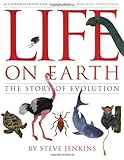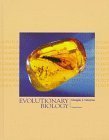|
|
Help |
| Home - Basic E - Evolution Biology (Books) | |
e99 Online Shopping Mall
|
|
Help |
| Home - Basic E - Evolution Biology (Books) | |
| 1-20 of 97 | Next 20 |
click price to see details click image to enlarge click link to go to the store
| 1. Life on Earth: The Story of Evolution by Steve Jenkins | |
 | Hardcover: 40
Pages
(2002-10-28)
list price: US$16.00 -- used & new: US$9.78 (price subject to change: see help) Asin: 0618164766 Average Customer Review: Canada | United Kingdom | Germany | France | Japan |
|
Editorial Review Product Description Customer Reviews (12)
| |
| 2. Evolution For Dummies by Greg Krukonis PhD, Tracy Barr | |
 | Paperback: 362
Pages
(2008-03-24)
list price: US$19.99 -- used & new: US$8.62 (price subject to change: see help) Asin: 0470117737 Average Customer Review: Canada | United Kingdom | Germany | France | Japan |
|
Editorial Review Product Description Customer Reviews (6)
| |
| 3. Directed Evolution Library Creation: Methods and Protocols (Methods in Molecular Biology) | |
 | Hardcover: 232
Pages
(2003-04-25)
list price: US$129.00 -- used & new: US$77.69 (price subject to change: see help) Asin: 1588292851 Canada | United Kingdom | Germany | France | Japan |
|
Editorial Review Product Description | |
| 4. Quantum Evolution: How Physics' Weirdest Theory Explains Life's Biggest Mystery (Norton Paperback) by Johnjoe McFadden | |
 | Paperback: 352
Pages
(2002-05-17)
list price: US$17.95 -- used & new: US$9.64 (price subject to change: see help) Asin: 0393323102 Average Customer Review: Canada | United Kingdom | Germany | France | Japan |
|
Editorial Review Product Description McFadden's writing is clear and sharp, and it shows a high regard for thereader's intelligence and patience for complex ideas. This is no airplanebook--except for those already well-versed in the latest in bothevolutionary theory and subatomic physics. The rewards of reading aregreat, and the author bows just enough to established theory that he mightmeet the fate of his intellectual predecessors. The ideas underlyingQuantum Evolution may be right or wrong, but they challenge receivedwisdom without plunging into dogmatism--and that's good science. --Rob Lightner Customer Reviews (28)
| |
| 5. The Biology and Evolution of Language by Philip Lieberman | |
 | Paperback: 392
Pages
(1987-01-01)
list price: US$30.50 -- used & new: US$23.95 (price subject to change: see help) Asin: 0674074130 Average Customer Review: Canada | United Kingdom | Germany | France | Japan |
Customer Reviews (1)
| |
| 6. Ecological Developmental Biology by Scott F. Gilbert, David Epel | |
 | Paperback: 375
Pages
(2008-12-01)
list price: US$54.95 -- used & new: US$30.10 (price subject to change: see help) Asin: 0878932992 Average Customer Review: Canada | United Kingdom | Germany | France | Japan |
|
Editorial Review Product Description Customer Reviews (3)
| |
| 7. Making Sense of Evolution: The Conceptual Foundations of Evolutionary Biology by Massimo Pigliucci, Jonathan Kaplan | |
 | Paperback: 236
Pages
(2006-11-15)
list price: US$30.00 -- used & new: US$24.45 (price subject to change: see help) Asin: 0226668371 Average Customer Review: Canada | United Kingdom | Germany | France | Japan |
|
Editorial Review Product Description Making Sense of Evolution explores contemporary evolutionary biology, focusing on the elements of theories—selection, adaptation, and species—that are complex and open to multiple possible interpretations, many of which are incompatible with one another and with other accepted practices in the discipline. Particular experimental methods, for example, may demand one understanding of “selection,” while the application of the same concept to another area of evolutionary biology could necessitate a very different definition. Customer Reviews (1)
| |
| 8. Why Evolution Is True by Jerry A. Coyne | |
 | Hardcover: 304
Pages
(2009-01-22)
list price: US$27.95 -- used & new: US$10.63 (price subject to change: see help) Asin: B002ZNJWJU Average Customer Review: Canada | United Kingdom | Germany | France | Japan |
|
Editorial Review Product Description Customer Reviews (133)
| |
| 9. Paleobotany, Second Edition: The Biology and Evolution of Fossil Plants by Thomas N. Taylor, Edith L. Taylor, Michael Krings | |
 | Hardcover: 1252
Pages
(2008-12-29)
list price: US$125.00 -- used & new: US$95.78 (price subject to change: see help) Asin: 0123739721 Average Customer Review: Canada | United Kingdom | Germany | France | Japan |
|
Editorial Review Product Description Customer Reviews (5)
| |
| 10. Evolution's Eye: A Systems View of the Biology-Culture Divide (Science and Cultural Theory) by Susan Oyama | |
 | Paperback: 288
Pages
(2000-01-01)
list price: US$23.95 -- used & new: US$19.77 (price subject to change: see help) Asin: 0822324725 Average Customer Review: Canada | United Kingdom | Germany | France | Japan |
|
Editorial Review Product Description Customer Reviews (1)
| |
| 11. Our Family Tree: An Evolution Story by Lisa Westberg Peters | |
 | Hardcover: 48
Pages
(2003-04-01)
list price: US$17.00 -- used & new: US$8.63 (price subject to change: see help) Asin: 0152017720 Average Customer Review: Canada | United Kingdom | Germany | France | Japan |
|
Editorial Review Product Description Customer Reviews (17)
| |
| 12. Environment, Development, and Evolution: Toward a Synthesis (Vienna Series in Theoretical Biology) | |
 | Hardcover: 328
Pages
(2003-11-01)
list price: US$47.00 -- used & new: US$7.33 (price subject to change: see help) Asin: 0262083191 Canada | United Kingdom | Germany | France | Japan |
|
Editorial Review Product Description | |
| 13. What Evolution Is by Ernst Mayr | |
 | Paperback: 336
Pages
(2002-10)
list price: US$16.95 -- used & new: US$4.19 (price subject to change: see help) Asin: 0465044263 Average Customer Review: Canada | United Kingdom | Germany | France | Japan |
|
Editorial Review Product Description At once a spirited defense of Darwinian explanations of biology and an elegant primer on evolution for the general reader, What Evolution Is poses the questions at the heart of evolutionary theory and considers how our improved understanding of evolution has affected the viewpoints and values of modern man. Science Masters Series Mayr, emeritus professor of zoology at Harvard University, has long been one of the world's foremost researchers in genetic and evolutionary theory. In this overview of past and current scientific thought, he discusses key concepts and terms, among them the origin of species, the (somewhat metaphorical) "struggle for existence," and agents of micro- and macroevolution. Somewhat against the grain, he argues against reduction and for the study of evolution at the phenotypic, not genetic, level. In his concluding pages, Mayr offers a careful overview of human evolution, adding his view that humankind is indeed unique--though "it has not yet completed the transition from quadrupedal to bipedal life in all of its structures." Advanced students of the life sciences, as well as readers looking for a survey of current evolutionary theory, will find Mayr's book a useful companion. --Gregory McNamee Customer Reviews (61)
| |
| 14. Directed Enzyme Evolution: Screening and Selection Methods (Methods in Molecular Biology) | |
 | Paperback: 370
Pages
(2010-11-02)
list price: US$115.00 -- used & new: US$115.00 (price subject to change: see help) Asin: 1617374725 Canada | United Kingdom | Germany | France | Japan |
|
Editorial Review Product Description | |
| 15. Biology, Evolution and Conservation of River Dolphins Within South America and Asia (Wildlife Protection, Destruction and Extinction) | |
 | Hardcover: 504
Pages
(2010-04)
list price: US$145.00 -- used & new: US$144.00 (price subject to change: see help) Asin: 1608766330 Canada | United Kingdom | Germany | France | Japan |
|
Editorial Review Product Description | |
| 16. The Evolution of Morality (Life and Mind: Philosophical Issues in Biology and Psychology) by Richard Joyce | |
 | Paperback: 288
Pages
(2007-09-30)
list price: US$19.00 -- used & new: US$14.97 (price subject to change: see help) Asin: 0262600722 Average Customer Review: Canada | United Kingdom | Germany | France | Japan |
|
Editorial Review Product Description Customer Reviews (4)
| |
| 17. Dog Behaviour, Evolution, and Cognition (Oxford Biology) by Ádám Miklósi | |
 | Paperback: 304
Pages
(2009-02-15)
list price: US$60.00 -- used & new: US$46.54 (price subject to change: see help) Asin: 0199545669 Average Customer Review: Canada | United Kingdom | Germany | France | Japan |
|
Editorial Review Product Description Customer Reviews (5)
| |
| 18. The Diversity of Fishes: Biology, Evolution, and Ecology by Gene Helfman, Bruce B. Collette, Douglas E. Facey, Brian W. Bowen | |
 | Hardcover: 736
Pages
(2009-05-19)
list price: US$129.95 -- used & new: US$58.50 (price subject to change: see help) Asin: 1405124946 Average Customer Review: Canada | United Kingdom | Germany | France | Japan |
|
Editorial Review Product Description Companion resources site This book is accompanied by a resources site: www.wiley.com/go/helfman The site is being constantly updated by the author team and provides: · Related videos selected by the authors · Updates to the book since publication · Instructor resources · A chance to send in feedback Customer Reviews (6)
| |
| 19. Modeling Biology: Structures, Behaviors, Evolution (Vienna Series in Theoretical Biology) | |
 | Hardcover: 400
Pages
(2007-10-31)
list price: US$50.00 -- used & new: US$33.75 (price subject to change: see help) Asin: 026212291X Canada | United Kingdom | Germany | France | Japan |
|
Editorial Review Product Description | |
| 20. Evolutionary Biology by Douglas J. Futuyma | |
 | Hardcover: 763
Pages
(1997-12)
list price: US$96.95 -- used & new: US$68.00 (price subject to change: see help) Asin: 0878931899 Average Customer Review: Canada | United Kingdom | Germany | France | Japan |
|
Editorial Review Product Description Customer Reviews (11)
| |
| 1-20 of 97 | Next 20 |